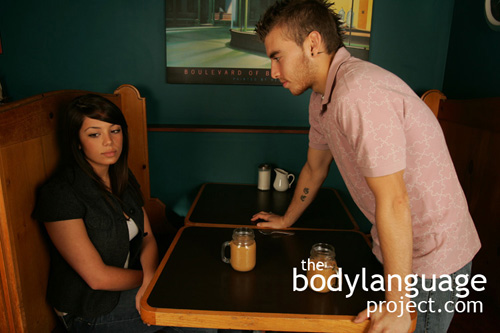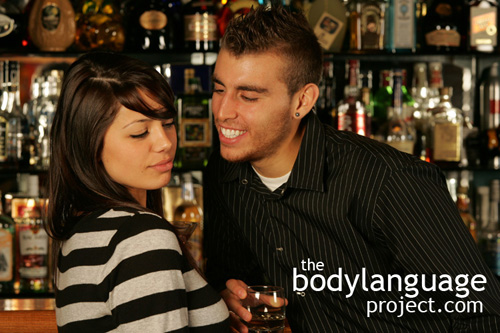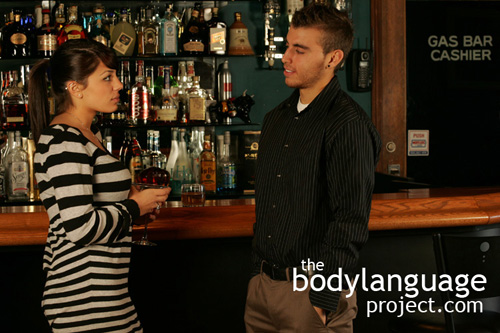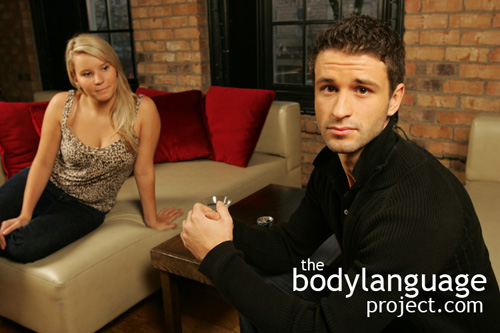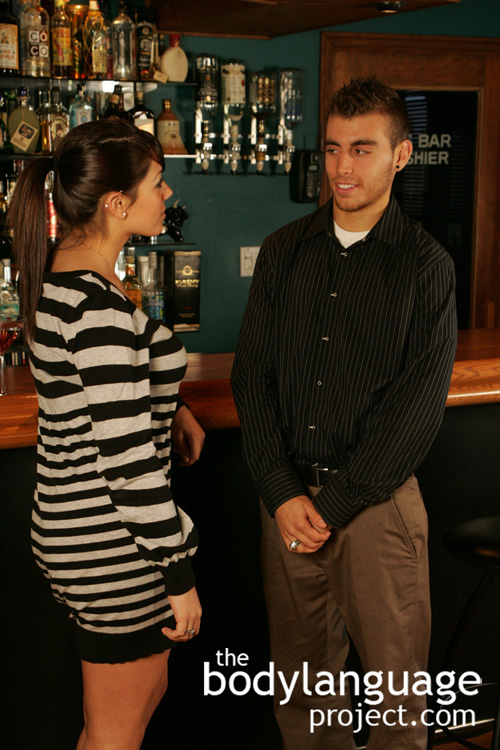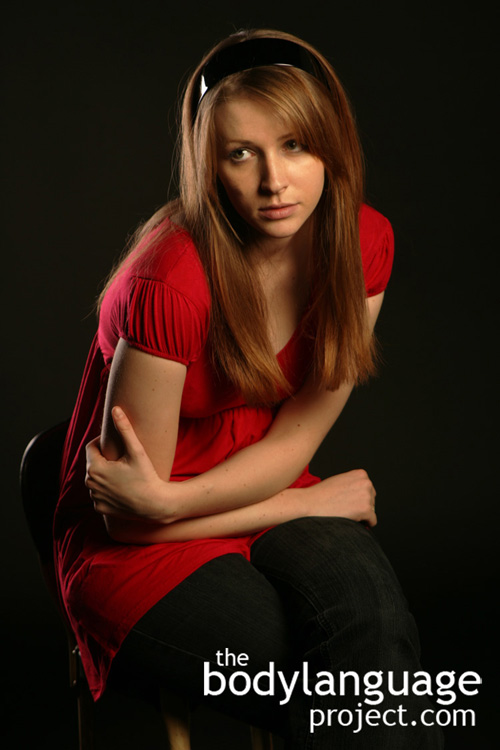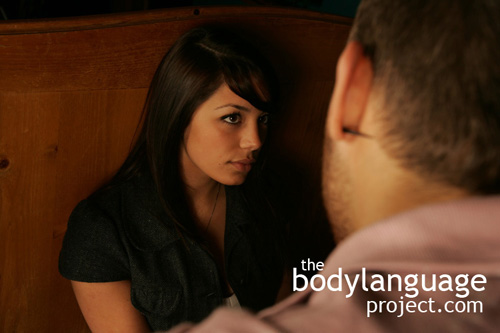Body Language of Head Away
Synonym(s): Head Pulled Back, Head Turned Away, Tilting Head Away.
Description: When the head is moved away rather than toward a person. This may be away from a person, object or even an idea.
In One Sentence: Moving the head away is a signal that a person is trying to escape an idea or another person.
How To Use it: Use the direction of your head (head language) to show other people that you don’t like their ideas. This is a low risk body language cue because it avoids using potentially volatile words. By moving the head away, it tells others that you do not like what they have to say. This can work in business, dating and amongst friends.
Context: General.
Verbal Translation: a) “I don’t like what I’m hearing, but my feet can not be moved away, lest I seem rude, so instead my head will be doing the escaping by moving away to create more distance between me and the thing I don’t like.” b) “I think you are too close to me so I’m leaning back to create more space between the two of us.” c) “I hate you, but feel like I shouldn’t just bolt away so I’m creating a space buffer by titling my head away.” d) “You have bad breath.”
Variant: Can happen sharply as if being taken aback or gradually as if being encroached upon. Conversely the head can move toward or be bowed down submissively showing agreement. See Blading Body Language, Body Angling or Ventral Displays, Toe Pointing or Pointed Toe.
Cue In Action: While engaged in conversation Jill shirked and pulled her chin in and turned her head to the side. She disagreed with her friend’s strong political assertion.
Meaning and/or Motivation: The head will be moved away when there is disagreement but also when the person is not able or permitted to escape entirely from a situation. Thus, it shows a desire for more space. A person might move their head back when someone is speaking with them too closely and violating their personal space, they have bad breath, are speaking too loudly, or they don’t like them for personal reasons.
This is a form of body withdrawal similar to ventral denial, or orienting the shoulders away from things people dislike and toward things they like. When someone wants to exit, the head might look toward the door or to another person.
Cue Cluster: The cue might be accompanied by a grimace facial expression, eye and mouth constriction, torso denial, stepping backward if possible and palm up expression as if wanting a better explanation.
Body Language Category: Amplifier, Confused, Defensive, Dislike (nonverbal), Distancing or moving away, Escape movements, Intention movements, Rejection body language.
Resources:
Broth, Mathias and Lorenza Mondada. Walking Away: The Embodied Achievement of Activity Closings in Mobile Interaction. Journal of Pragmatics. 2013. 47: 41-58.
http://bodylanguageproject.com/articles/nonverbally-negotiate-conversation-walking-away/
Beall, Alec and Jessica L. Tracy. The Puzzling Attractiveness of Male Shame. Manuscript submitted to Evolutionary Psychology. www.epjournal.net – 2014. 12(x): 1-39
http://bodylanguageproject.com/articles/male-nonverbal-shame-attractive/
Costa, M., Menzani, M., & Ricci Bitti, P. E. Head canting in paintings: An historical study. Journal of Nonverbal Behavior. 2001. 25: 63–73.
Costa, M., & Ricci Bitti, P. E. Face-ism effect and head canting in one’s own and others’ photographs. European Psychologist. 2000. 5: 293–301.
Chance RMA (1962) An interpretation of some agonistic postures: the role of “cut-off” acts and postures. Symp Zool Soc Lond 8: 71–89.
Furley, Philip and Geoffrey Schweizer. “I’m Pretty Sure That We Will Win!”: The Influence of Score-Related Nonverbal Behavioral Changes on the Confidence in Winning a Basketball Game Journal of Sport & Exercise Psychology. 2013. 35:316-320. http://dx.doi.org/10.1123/jsep.2013-0199
http://bodylanguageproject.com/articles/losers-nonverbal-behavior-boosts-confidence-winners-study/
Goodboy, Alan, K. and Maria Brann. Flirtation Rejection Strategies: Towards an Understanding of Communicative Disinterest in Flirting. The Quantitative Report. 2010. 15(2): 268-278.
http://bodylanguageproject.com/articles/how-to-reject-flirting-using-nonverbal-and-verbal-tactics/
Hehman, Eric; Jordan B. Leitner and Samuel L. Gaertner. Enhancing Static Facial Features Increases Intimidation. Journal of Experimental Social Psychology. 2013; 49: 747-754.
http://bodylanguageproject.com/articles/tilting-the-head-is-display-of-intimidation-study/
Hietanen, Jari. Social attention orienting integrates visual information from head and body orientation. Psychological Research.2002 66(3): 174-179.
Hietanen, J. K. (1999). Does your gaze direction and head orientation shift my visual attention? Neuroreport, 10, 3443–3447.
Hietanen, Jari. Social attention orienting integrates visual information from head and body orientation. Psychological Research.2002 66(3): 174-179.
Hwang, Hyisung C. and David Matsumoto. Cultural Differences in Victory Signals of
Triumph Cross-Cultural Research. SAGE Publications 2014. 48(2):177– 191.
http://bodylanguageproject.com/articles/culture-nonverbal-triumph/
Harrigan J. and Rosenthal R. Physicians’ head and body positions as determinants of perceived rapport. J. appl. Sot. Psychol. 13, 496, 1983.
Hillel, Aviezer, Yaacov Trope, Alexander Todorov. Body Cues, Not Facial Expressions, Discriminate Between Intense Positive and Negative Emotions. Science 338, 1225 (2012).
http://bodylanguageproject.com/articles/body-language-trumps-facial-expressions-read-my-body-not-my-lips/
Horley K, Williams LM, Gonsalvez C, Gordon E (2003) Social phobics do not see eye to eye: a visual scanpath study of emotional expression processing. J Anxiety Disord 17:33–44
Jenkins, R., Beaver, J.D., & Calder, A.J. (2006). I thought you were looking at me: Direction-specific aftereffects in gaze perception. Psychological Science, 17, 506–513.
Jenkins, R., Keane, J., & Calder, A.J. (2007, August). From your eyes only: Gaze adaptation from averted eyes and averted heads. Paper presented at the Thirtieth European Conference on Visual Perception, Arezzo, Italy.
Kaminski, Juliane ; Call, Josep ; Tomasello, Michael. Body orientation and face orientation: two factors controlling apes’ begging behavior from humans
Animal Cognition. 2004. 7(4): 216-223.
Keltner, D. The signs of appeasement: Evidence for the distinct displays of embarrassment, amusement, and shame. Journal of Personality and Social Psychology. 1995. 68: 441–454.
Krumhuber, Eva; Antony S. R.; Manstead; and Arvid Kappas. Temporal Aspects of Facial Displays in Person and Expression Perception: The Effects of Smile Dynamics, Head-tilt, and Gender. Journal Nonverbal Behavior. 2007; 31: 39-56.
DOI 10.1007/s10919-006-0019-x
http://bodylanguageproject.com/articles/head-tilt-and-slow-onset-smile-nonverbals-trust-attraction-dominance-and-flirting-a-brief-report/
Katza, Carmit; Irit Hershkowitz; Lindsay C. Malloya; Michael E. Lamba; Armita Atabakia and Sabine Spindlera. Non-Verbal Behavior of Children Who Disclose or do not Disclose Child Abuse in Investigative Interviews. Child Abuse & Neglect. 2012. 36: 12-20.
http://bodylanguageproject.com/articles/reading-nonverbal-behaviour-child-abuse-cases-encourage-children-divulge-information-truth-telling
Kaminski, Juliane ; Call, Josep ; Tomasello, Michael. Body orientation and face orientation: two factors controlling apes’ begging behavior from humans
Animal Cognition. 2004. 7(4): 216-223.
Lawson, Rebecca P. ; Clifford, Colin W. G. ; Calder, Andrew J. About Turn: The Visual Representation of Human Body Orientation Revealed by Adaptation. Psychological Science. 2009. 20(3): 363(9).
Langton, S. R. H., & Bruce, V. (1999). Reflexive visual orienting in response to the social attention of others. Visual Cognition, 6, 541–567.
Langton, S.R.H. (2000). The mutual influence of gaze and head orientation in the analysis of social attention direction. Quarterly Journal of Experimental Psychology A: Human Experimental Psychology, 53, 825–845.
Martina Mara and Markus Appel. Effects of Lateral Head Tilt on User Perceptions of Humanoid and Android Robots. Computers in Human Behavior. 2015. 44: 326-334
http://bodylanguageproject.com/articles/nonverbal-head-tilt-says-robot/
Martens, Jason P.; Jessica L. Tracy and Azim F. Shariff. Status signals: Adaptive
benefits of displaying and observing the nonverbal expressions of pride and shame, Cognition & Emotion. 2012. 26(3): 390-406. DOI: 10.1080/02699931.2011.645281
http://bodylanguageproject.com/articles/significant-nonverbal-expression-pride-shame-body-language-detailed-examination-origin-function/
Mehrabian, Albert Holzberg, Jules D. (editor). Inference of Attitudes From the Posture, Orientation and Distance of a Communicator. Journal of Consulting and Clinical Psychology. 1968. 32(3): 296-308.
Mehrabian, Albert Deese, James (editor). Significance of posture and position in the communication of attitude and status relationships. Psychological Bulletin. 1969. 71(5): 359-372.
Nelson, Nicole L and James A. Russell. Children’s Understanding Of Nonverbal Expressions Of Pride. Journal of Experimental Child Psychology. 2012; 111: 379-385.
http://bodylanguageproject.com/articles/can-children-read-pride-body-language/
Navarro, Joe. 2008. What Every BODY is Saying: An Ex-FBI Agent’s Guide to Speed-Reading People. William Morrow Paperbacks.
Ponari, Marta ; Trojano, Luigi ; Grossi, Dario ; Conson, Massimiliano. “Avoiding or approaching eyes”? Introversion/extraversion affects the gaze-cueing effect. Cognitive Processing. 2013. 14(3): 293-299.
Rule, Nicholas, O.; Reginald B. Adams Jr.; Nalini Ambady and Jonathan B. Freeman. Perceptions Of Dominance Following Glimpses Of Faces And Bodies. Perception. 2012; 41: 687-706 doi:10.1068/p7023
http://bodylanguageproject.com/articles/people-can-read-dominance-split-second
Robinson, Jeffrey David. Getting Down to Business Talk, Gaze, and Body Orientation During Openings of Doctor-Patient Consultations. Human Communication Research. 1998. 25(1): 97-123.
Sturman, Edward D. Invluntary Subordination and Its Relation to Personality, Mood,
and Submissive Behavior. Psychological Assessment. 2011. 23(1): 262-276 DOI: 10.1037/a0021499
http://bodylanguageproject.com/articles/nonverbal-submission-men-women-depression-critical-examination-use-disuse-submission/
Shariff, Azim F. and Jessica L. Tracy. Knowing Who’s Boss: Implicit Perceptions of Status From the Nonverbal Expression of Pride. Emotion. 2009.9(5): 631-639.
http://bodylanguageproject.com/articles/can-you-tell-whos-boss-by-the-nonverbal-expression-of-pride/
Schouwstra SJ, Hoogstraten J (1995) Head position and spinal position as determinants of perceived emotional state. Percept Mot Skills 81: 673–674. doi: 10.2466/pms.1995.81.2.673.
Straube, Thomas ; Langohr, Bernd ; Schmidt, Stephanie ; Mentzel, Hans-Joachim ; Miltner, Wolfgang H.R. Increased amygdala activation to averted versus direct gaze in humans is independent of valence of facial expression. NeuroImage. 2010 49(3): 2680-2686.
Tracy, Jessica L. and Richard W. Robins. The Nonverbal Expression of Pride: Evidence for Cross-Cultural Recognition. Journal of Personality and Social Psychology. 2008. 94(3): 516–530. DOI: 10.1037/0022-3514.94.3.516
http://bodylanguageproject.com/articles/nonverbal-expression-pride-recognized-cross-culturally/
Tracy, Jessica L. and Alec T. Beall. Happy Guys Finish Last: The Impact of Emotion Expressions on Sexual Attraction Emotion. American Psychological Association. 2011; 11(6): 1379–1387
http://bodylanguageproject.com/articles/happy-guys-finish-last-happy-women-finish-first-says-new-study-on-sexual-attractiveness/
Tracy, Jessica L. and David Matsumoto. The Spontaneous Expression Of Pride And Shame: Evidence For Biologically Innate Nonverbal Displays. 2008; 105 (33) 11655-11660.
http://bodylanguageproject.com/articles/universal-expressions-of-pride-and-shame/
Underwood, M. K.. Glares of Contempt, Eye Rolls of Disgust and Turning Away to Exclude: Non-Verbal Forms of Social Aggression among Girls. Feminism & Psychology. 2004 14(3): 371-375
Pablo Briñol; Richard E. Petty and Benjamin Wagner. Body Posture Effects on Self-Evaluation: A Self-Validation Approach. European Journal of Social Psychology. 2009. 39(6): 1099-0992. DOI: 10.1002/ejsp.607. http://dx.doi.org/10.1002/ejsp.607
http://bodylanguageproject.com/articles/fix-posture-fix-confidence/
Wirth, James H ; Sacco, Donald F ; Hugenberg, Kurt ; Williams, Kipling D. Eye gaze as relational evaluation: averted eye gaze leads to feelings of ostracism and relational devaluation. Personality & social psychology bulletin. 2010 36(7): 869-82.
Zeinstra, Gertrude G.; M.A. Koelen; D. Colindres ; F.J. Kok; C de Graaf. Facial Expressions in School-Aged Children are a Good Indicator of ‘Dislikes’, but not of ‘Likes.’ Food Quality and Preference. 2009. 20: 620-624.
http://bodylanguageproject.com/articles/read-kids-dislike-food-facial-expressions-accurate-detecting-dislike-not-like-children/

